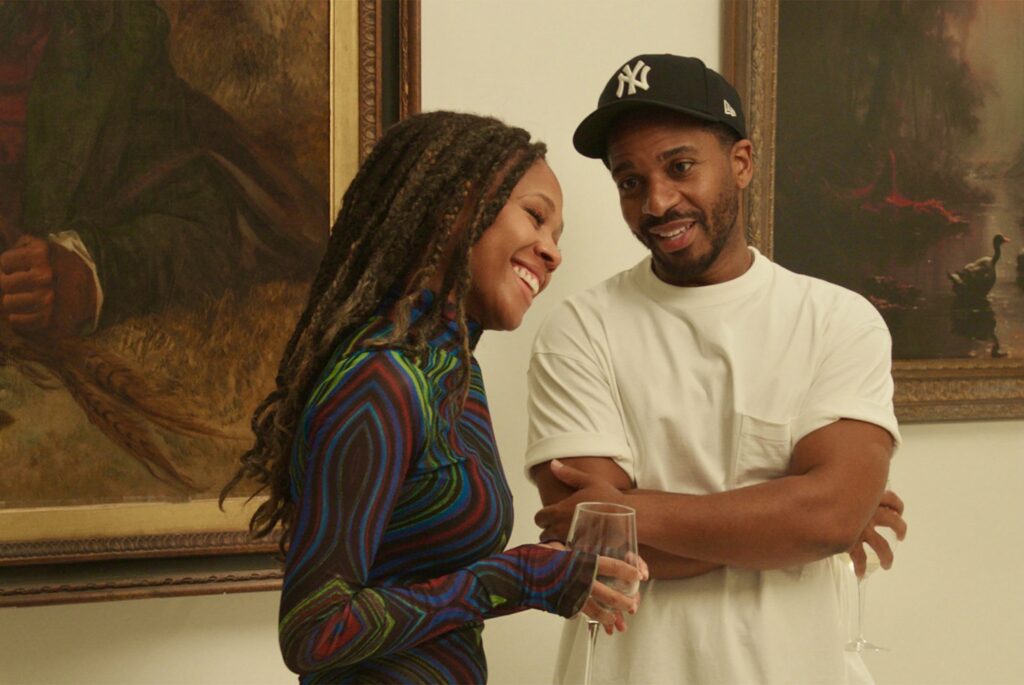
(**1/2)
He loves her. He loves her not. She loves him, she loves him not. That’s why they broke up and he has a new lady on the side.
TV series director turned filmmaker Rachael Holder has love and triads on her mind. That’s got to be the reason she’s teamed with first time screenwriter Paul Zimmerman to tell this romantic, urban dramedy set on the streets of New York’s largest borough, Brooklyn. A place where brownstones dot the avenues and the people inside them each have a unique story.
Roger (André Holland, Moonlight), a writer, bikes around the neighborhood of Fort Green, Bklyn like he’s on a mission. He is. He’s gathering notes and experiences about the gentrification of his old middle-class black community. Roger observes, “The people who like made the neighborhood, who built the culture, can no longer afford to live in the damn neighborhood.” He expresses that opinion with friends and lovers. Like his new sweetheart, Nicole (DeWanda Wise). They’re friends with benefits and her young daughter Ally (Cadence Reese) is starting to like her single mom’s new best man.
There’s a slight complication. The journalist still has a crush on his ex, Casey (Nicole Beharie). She runs an art gallery in the vicinity and hasn’t gotten him out of her head. Also, her building is being sought by gentrifiers. But it’s an heirloom, once owned by her grandmother. Casey’s heart says, “Don’t sell,” but her bank account screams, “Sell.” She’s as ambivalent as she is with Roger’s feelings.
Educated, middle-class black people in Brooklyn have been depicted in films before—especially by male directors like Spike Lee. Holder’s interpretation of life in BKLYN shows a great sensitivity to men and women’s emotions and dreams. Great setup. Believable characters. Dialogue and opinions that feel like they’ve been ripped from coffee shops along Lafayette and Dekalb Avenues in Fort Green or cafes in Clinton Hill and Bedford Stuyvesant. Gathering places where Black populations are dwindling. Where demographics are changing, just like in other urban centers.
The social aspects of gentrification are not a new film theme. Nothing in this script distinguishes itself from similar minded movies like The Last Black Man in San Francisco. This depiction is unique because of its poetic love story and relatable characters. The kind prevalent on TV or streaming service series. Something that’s a cross between Friends and Prime VIdeo’s Harlem.
If this project was in an episodic format, the relatable Roger character would build a fan base. Ditto for the people he hangs with, particularly his married friend Alan (Roy Wood Jr.). Nicole’s journey as a single mom, navigating life with a young daughter would attract young female demographics. Oddly, the Casey character might get the most play. She’s fascinating, complex, torn by emotions, allegiance and tradition. A troublemaker who would be fun to follow. Credit Zimmerman for the engaging secondary characteristics and the cast for further developing the personalities. Particularly Holland and Beharie.
Holder creates and sustains an everyday kind of tone. She knows her subjects, their concerns and how to stage them. There’s a shot of Roger jogging through a park at the base of a hill, and he spies Nicole and Ally at the top of the crest. As he walks towards them, grass below, sun in sky, a feeling of rebirth and new chances is cast in the most subtle way. That scene typifies Holder’s visual style, cinematographer Martim Vian’ sense of lighting and costume designer Missy Mickens’ knack for clothing characters. It’s a moment of Brooklyn’s magic.
Also, the playlist consistently adds atmosphere at just the right times. Like Leon Thomas’s “Breaking Point” playing the night Roger shows up at Nicole’s house drunk, looking for some. Or “Colors” by Black Puma accentuating a scene when Roger has a cathartic moment. You gotta love the music.
However, anyone looking for a story that features a protagonist in a compelling fight against an evil antagonist, will be disappointed. Anyone hoping for deep emotions that put you on a rollercoaster, will be disenchanted. This is a small, indie slice-of-life tale and character study. Charming, yes. Riveting, no. It’s like being invited over to someone’s brownstone for a dinner party, sitting around a table and hearing stories you’ve heard elsewhere. Even the potentially provocative woman-man-woman triad never gets as torrid as it could be.
There’s just enough drama and romance for a series or a streaming service. Not enough to get mobs to run to the local cineplex. That might not be the filmmakers’ intention. But that’s the probability for this love and not in love affair.
Photos courtesy of the Sundance Film Institute.
For more information about the Sundance Film Festival go to: https://festival.sundance.org
Visit Film Critic Dwight Brown at DwightBrownInk.com.